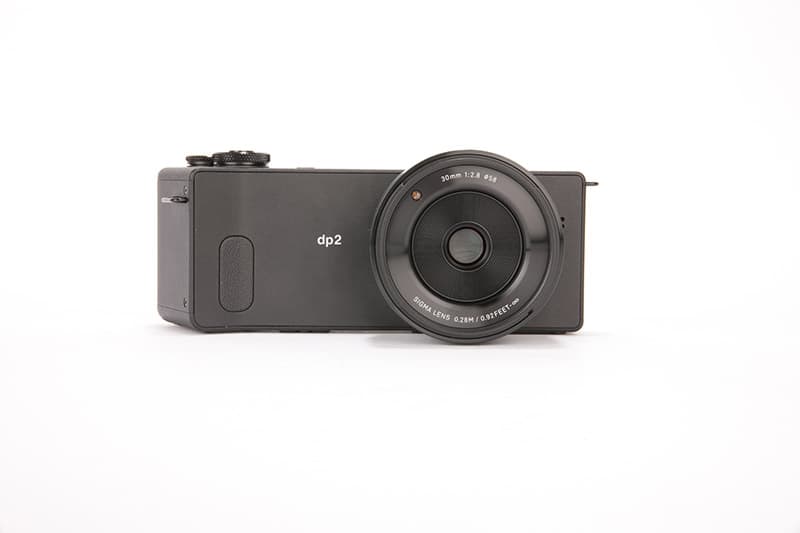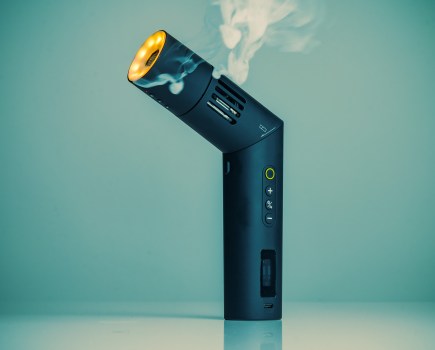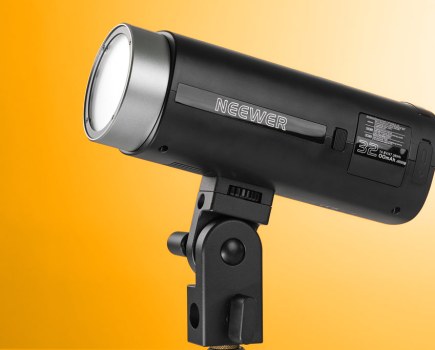Sigma dp2 Quattro – Pros
-
Exceptional low-ISO image quality
- Extraordinarily sharp lens
- Good control layout
Sigma dp2 Quattro – Cons
- Poor quality at ISO 1600 and above
- Uncomfortable hand grip
- Bulky, awkward body shape
Sigma dp2 Quattro review – Introduction
In the early days of digital photography, camera manufacturers experimented with all sorts of different body designs.
Some disappeared without trace, but others became seen as modern classics, perhaps most notably Nikon’s split-body Coolpix models of the early 2000s. But over time, designs have generally become more and more conservative, and now almost all digital cameras look very much like film cameras did.
Which brings us to the dp2 Quattro. Sigma was actually the first to place a large, APS-C-sized sensor in a fixed-lens compact camera, with the original DP1 Merill. The concept has been through several generations, and expanded to three lenses offering 28mm, 45mm and 75mm equivalent angles of view.
But until now, the actual camera designs have been decidedly conservative square boxes with lenses on the front. The Quattro, in contrast, is very different indeed.
Sigma’s latest model has an extremely unconventional design. It has a wide, low, slim body, with the lens offset towards the right. But the real talking point is its grip, which is an odd-looking affair that sticks out at an angle from the back of the camera. It’s certainly an attention-grabbing look.

Sigma dp2 Quattro review- Features
Once we get past the physical design and start looking at the camera’s key features, it’s still decidedly unusual. It features an APS-C-sized (23.5 x 15.7mm) sensor, with the unique Foveon multi-layer design. In short this design uses three stacked layers with different colour sensitivities, in contrast to conventional sensors that measure either red, green or blue light at any given pixel location.
This gives Foveon images a unique look, traditionally showing impressive detail resolution and unusually fine pixel-to-pixel colour gradation. However, the design has also had its problems, most notably with image noise at only moderately high sensitivities of ISO 800 or more. The raw images generally can’t be processed using mainsteam software either, but instead require Sigma’s own Photo Pro converter.
On front of the sensor is a fixed 30mm f/2.8 lens that gives an angle of view equivalent to 45mm on full frame. You won’t find any other fixed-lens cameras sporting such a thing – most use wider 35mm or 28mm equivalent primes. However, this focal length counts as a ‘normal’ lens, which gives a very natural-looking perspective to images that is favoured by many photographers (myself included). The lens has a 58mm filter thread, and a bayonet mount for the matched hood.
A top-plate hotshoe is provided for auxiliary lighting, but there’s no built-in flash. Images are recorded to an SD card that sits behind a thick rubber cover on the camera’s left side, which also conceals a USB socket that can accept a cable release. But there’s no HDMI port, as the Quattro doesn’t record video.
Sigma dp2 Quattro review – Build and handling
With a magnesium-alloy shell and chunky metal top-plate dials, the Quattro feels like an extremely well-made piece of kit. The body exudes a sense of solidity, with no hint of give or creaking, and all of the controls are fast and responsive.
The control layout is very good too. Those twin dials on the top-plate are used to change exposure settings, and the lens has a manual focus ring. Dedicated buttons are provided for focus mode (auto or manual), focus area selection, and auto-exposure lock. There’s no exposure mode dial, but instead a top-plate button allows selection from program, aperture priority, shutter priority and manual modes, plus three user-programmable custom set-ups.
Other key functions, including ISO, can be accessed quickly using the QS (quick set) button. This brings up an on-screen menu that’s much more intuitive to navigate than Sigma’s previous efforts, and which can be configured to each photographer’s individual preference. Overall, the Quattro’s user interface is much more refined than in previous Sigma models, with very little to complain about at all.
The elephant in the room, of course, is that grip. It certainly feels very odd on first impression, but after a few days’ use I got the hang of it. It makes a surprisingly comfortable handle for carrying the camera around one-handed, especially if you forgo the supplied neck strap and use a wrist strap instead. It’s not too bad while shooting either, although a lot of thumb movement is required to change settings as the rear buttons are at two very different depths. I found it works best if you hold the camera high up to eye level and use your left hand to support the lens.

The thing is, it doesn’t obviously solve a problem. I’ve used a lot of small, high-end cameras over the past few years, and I can’t honestly say that the Quattro’s grip works better than any others. But it does add extra bulk, and makes the camera more awkward to fit in a bag. I can’t help but think that a more conventional design would have been a better idea.
Sigma dp2 Quattro review – LCD and viewfinder

On the Quattro’s back is a 3in, 920,000-dot screen. It’s sharp and detailed, and shows lots of useful information including (optionally) a live histogram and electronic level display. It’s neither articulated nor touch-sensitive, and while these features aren’t found on most of the Quattro’s direct competitors either, they’re quite common on small compact system cameras.
If you want to use an eye-level viewfinder, you can slide an optical one onto the hotshoe, but there’s no facility to use an external electronic viewfinder. Instead, the Quattro provides a display mode that shows all of the usual shooting information on the rear screen, just without the live view display. You can also turn the LCD off completely if you like.
Performance
Sigma dp2 Quattro review – Autofocus
Sigma’s previous DP models haven’t exactly been known for snappy focusing – in fact, rather the opposite. Thankfully, the Quattro is distinctly improved in this respect, to the extent that the camera no longer feels like it’s holding you up as it homes in on the subject.
You can move the focus area freely around the central region of the frame, across about half the image’s width and height, or use a quicker-to-select nine-point mode. It’s also possible to change the size of the focus box in three steps, allowing precise focus on a specific subject, and face detection AF is also available.
Once light levels drop, the Quattro’s autofocus gets much less certain. It’s OK in a well-lit interior, but under domestic artificial lighting it’s really not very happy at all, and often fails to confirm focus.
In these cases, switching to manual focus may well be the most reliable approach. But here we’re also talking about situations where you’re likely to be shooting at high ISOs, which really isn’t the Foveon sensor’s forte at all.
Sigma dp2 Quattro review – Metering
The Quattro meters using the main image sensor and, like other cameras that employ this approach, it tends to give generally well-judged exposures. It also previews the exposure on screen and offers a live histogram while shooting. So when you do disagree with the camera’s judgement, it’s easy enough to apply a touch of exposure compensation using the rear command dial. For tricky lighting situations, you can also switch to spot metering using the QS menu.

Image: The lens’s f/2.8 aperture allows for shallow depth of field effects at close distances
Resolution, dynamic range and noise
Sigma dp2 Quattro review – Resolution

The Quattro’s resolution is hugely impressive at low ISO settings, at around 3600lp/ph, which is about as high as it could possibly record given its pixel count.
In raw it gradually falls at higher ISO settings, to about 2400lp/ph at ISO 400. But in JPEGs, it literally halves at ISO 1600 to 1800lp/ph due a change in processing mode, then drops to about 1600lp/ph at ISO 6400.
Sigma dp2 Quattro review -Dynamic range

The pattern here confirms the Quattro as a low ISO camera. Dynamic range is very respectable at ISO100, at about 1.6EV, but it falls off very quickly from ISO 400 onwards. A value of 8.7 EV at ISO 800 isn’t great for an APS-C sensor, and dynamic range falls monotonously thereafter, indicating a lack of ability to record shadow detail.
Sigma dp2 Quattro review -Noise

At low ISO settings, the Quattro gives extremely clean images, but things start to go badly awry at ISO 1600 and above. JPEGs are practically unusable at ISO 3200 and 6400, and while raws aren’t so bad, they show exceptionally high luminance noise.
Sigma dp2 Quattro review – Image Quality
Let’s get one thing absolutely straight: the Quattro’s image quality at low ISO settings is little short of astonishing. Its lens is simply superb, being sharp from corner to corner with no visible chromatic aberration, even when shot at f/2.8. There’s visible (but not objectionable) vignetting when wide open, which disappears by f/4, and a touch of barrel distortion. Overall, this is one of the best optics I’ve ever seen on a fixed-lens camera.The Foveon X3 Quattro image sensor is in its element at ISO 100-400, delivering incredibly sharp, detailed images that look quite unlike files from conventional Bayer-sensor cameras. The pixel-level detail is extraordinary, aided by that wonderful lens, and the sensor is capable of recording subtle changes of colour and tonality from pixel to pixel. So while the sensor’s native output resolution is 19.6 million pixels, it can often match a conventional Bayer sensor with a much higher pixel count for detail.

Image: The dp2 Quattro is capable of outstanding low ISO image quality, thanks to a lens that’s pin-sharp from the centre to the corners
Indeed, to reflect this, JPEG shooters now get the option to output at 39 million pixels, although I’m not convinced there’s much point – they’re just larger files with no more actual detail (and which can’t be shot alongside raw).
The camera’s auto white balance works well, and the JPEG colour output seems richer and more vibrant than from previous Sigma cameras I’ve used, when shot in the default standard mode. A number of alternative colour modes are on offer too, each with fine-tuning of contrast, sharpness and saturation. This means that most users should be able to get images they like straight out of the camera.
Sigma dp2 Quattro review – High ISO performance
Foveon cameras have always been known as being best for low ISO work, something that the Quattro sensor design is supposed to address. In this regard, the camera’s image quality holds up pretty well to ISO 800, although colours can start to smear and desaturate, and shadow detail starts to disappear.
However, at ISO 1600 something very strange occurs to the camera’s JPEG output. The Quattro seems to change its processing mode completely, working at the 4.9-million-pixel resolution of the sensor’s lower layers, then upsampling to 19.6 million pixels. The result is a severe drop in detail, while areas of solid colour can look like they’ve been crudely painted on.

Image: 100% crop from ISO 1600 jpg file from the Sigma dp2 Quattro
Despite this resolution drop, the noise performance still isn’t great, with the Foveon design’s signature green and purple blotching appearing in midtones and shadows. At higher ISO settings, random spots of colour start to appear where the camera misinterprets this noise as real image information, and its noise reduction systems saturate rather than desaturate it.
To get the best high ISO images, it’s therefore imperative to shoot raw. This means processing the resulting images with Sigma Photo Pro 6 – the only program that understands the Quattro’s files.
It’s much, much better at suppressing the sensor’s unusual noise pattern than the camera’s own processing, and can provide reasonable output as high as ISO 3200, although it’s still some way behind cameras that use conventional sensors.

Image: 100% crop from corresponding RAW file converted using Sigma Photo Pro
The price you pay, though, is that Pro Photo is an unintuitive, slow, resource-hungry application that takes an interminable length of time to process raw files, during which you can’t do anything else with the software.
Sigma dp2 Quattro review – Our verdict
The dp2 Quattro is one of the most difficult cameras to judge that I’ve used recently. At its best, with plenty of light to play with, it offers astounding image quality from the marriage of an exceptional lens and unconventional Foveon sensor. But at higher ISO settings, that very same sensor is its undoing, giving noisy, sub-par images. It really is best to stick to ISO 800 and below, which effectively rules out handheld shooting in low light.
In terms of design and handling, its oddball shape works quite well when you get used to it, although not obviously better than more conventional designs. However, it does takes up a larger, more strangely shaped space in a bag than cameras like the truly compact Ricoh GR, or the retro-styled Fujifilm X100S.
I’ve been impressed by much of what Sigma has done recently – its Art range of lenses has been very special indeed. I’m less sure about the Quattro, though. In a form factor closer to the Merrill models, with a conventional handgrip at the front of the camera alongside the lens, it could have been something pretty special. Instead, it seems destined to be yet again a niche seller for Sigma, bought only by those willing to trade off practicality for the undeniably excellent low ISO image quality it can deliver.

Hands-on First Look
Before we reviewed ths Sigma DP2 in full, we took a hands-on first look back in March. You can read our initial thoughts of the camera below…
Sigma dp2 Quattro at a glance:
- 29-million-pixel resolution (3:2 aspect ratio)
- APS-C-type (23.5×15.7mm) CMOS sensor
- TRUE III processor
- Raw & JPEG file formats
- 9-point AF
- 30mm f/2.8 (45mm equivalent) lens
- ISO 100-6400
- Price and availability to be confirmed
There has been a lot of emphasis on camera design in recent years. This has helped to revitalise the camera market by providing a wide range of designs from which photographers can choose. However, few could have predicted the direction Sigma would take with its new generation dp series.
The dp range
We’ll come onto the elongated design later, but first let’s look at the dp range. The Sigma dp2 Quattro is one of three models in a range of fixed-lens compacts, slotting in between the dp1 Quattro and the dp3 Quattro. Much like Sigma’s existing Merrill range, the key difference between each camera is the lens.
Whereas the dp2’s 30mm fixed lens offers a field of view that is equivalent to 45mm, the dp1’s 19mm lens squeezes more in the frame, equivalent to 28mm, while the dp3’s 50mm lens is equivalent to 75mm. Each model will use the company’s latest APS-C Foveon X3 Quattro sensor – a new variation of the multi-layer sensor we’ve seen before.
Designed to capture colour vertically, recording hue, value and chroma accurately and completely for every pixel, the new sensor samples 19.6 million pixels of data on its top layer and 4.9 million pixels on the two layers beneath. This should speed up processing, improve noise characteristics and, it has been alleged, offer a 30% improvement in resolution.
The sensor is paired with a new TRUE III image-processing engine to deliver what Sigma describes as outstandingly rich colour that is claimed to be more faithful than ever before.
The design

The motive for the obscure design is to provide a more substantial handgrip and allow the camera to accept a larger battery to improve battery life. Due to our mock-up sample not being operational, we can’t comment on performance. However, it did provide us with an impression of what we can expect from its handling. The body felt slimmer than expected and the first obvious omission is the lack of a rubber grip to give it a tactile feel.
The protruding lens naturally lends itself to being supported by the left hand and in that respect it is rather similar to holding a DSLR, albeit not as comfortable. Holding the camera in this way makes you want to lift it up to your eye, and rather than composing via the dp2’s 3in, 920,000-dot screen, it needs an optical viewfinder – an accessory that Sigma will offer as an optional extra.
In use
Operation of the camera feels as though it could be let down by the positioning of buttons, and we have yet to find out why there is no dedicated mode dial and only two dials on the top-plate to control aperture and shutter speed.

Based on our brief handling experience, the build quality of the Sigma dp2 Quattro is not as rigid as we’d hoped for and it certainly looks to have its work cut out if it is to challenge its closest fixed-lens compact rivals. We expect the Sigma dp2 Quattro to excel in its image quality, but we’ll have to wait for our review sample to find out whether this is the case.








